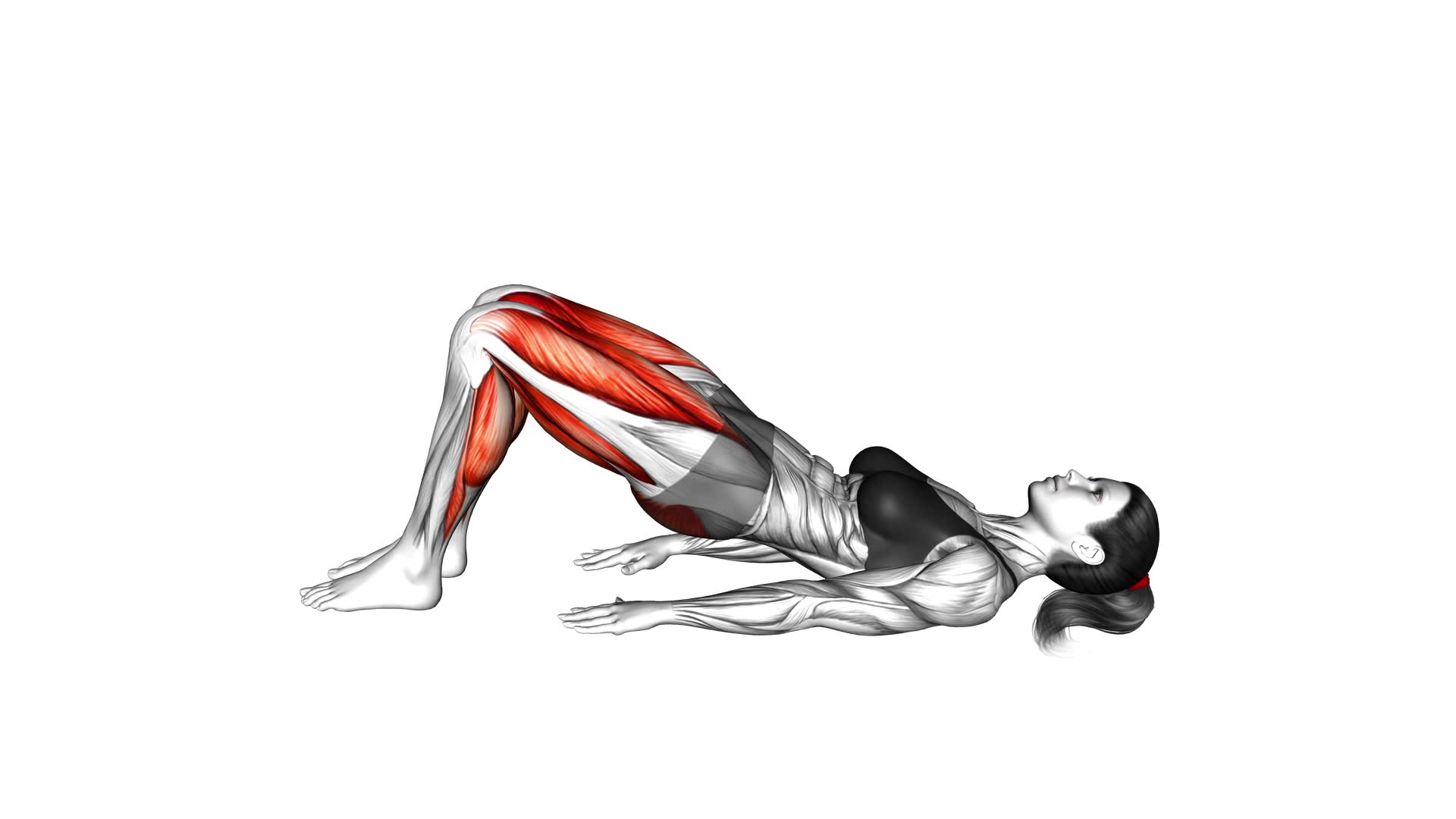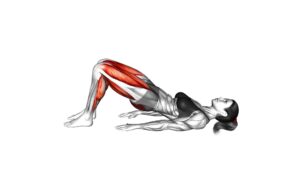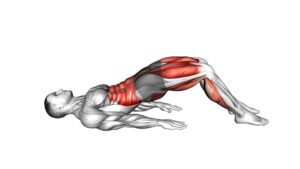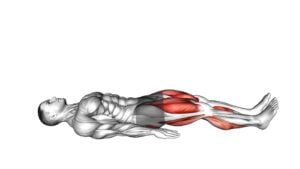Bridge Walk Leg Raise (female) – Video Exercise Guide & Tips

Are you looking for a quick and effective exercise to tone your legs and core? Look no further than the bridge walk leg raise.
Watch This Exercise Video
This video exercise guide will show you the proper form and give you helpful tips to maximize your results.
Whether you're a beginner or an experienced fitness enthusiast, this exercise can be modified to suit your needs.
Get ready to feel the burn and get those legs in shape!
Key Takeaways
- The Bridge Walk Leg Raise targets glutes, hamstrings, and core muscles.
- Proper form and technique are important to avoid injury and maximize results.
- Beginners can start with modified versions and gradually increase difficulty.
- Consistency, nutrition, and rest are key for recovery and muscle development.
Benefits of the Bridge Walk Leg Raise
You will experience several benefits from incorporating the Bridge Walk Leg Raise into your exercise routine. This exercise not only targets your glutes, hamstrings, and core, but it also helps improve your balance and stability. Unlike traditional leg exercises, the Bridge Walk Leg Raise engages multiple muscle groups simultaneously, making it a time-efficient alternative to other exercises.
One of the common mistakes people make when performing the Bridge Walk Leg Raise is lifting their hips too high, which can strain the lower back. To avoid this, focus on maintaining a straight line from your knees to your shoulders throughout the movement. Another mistake isn't engaging the glutes enough, which can result in limited benefits. To maximize the effectiveness of this exercise, squeeze your glutes at the top of the movement and maintain tension throughout.
In addition to its physical benefits, the Bridge Walk Leg Raise also helps improve your posture by strengthening the muscles that support your spine. By incorporating this exercise into your routine, you can reduce the risk of lower back pain and improve your overall functional fitness.
Now that you understand the benefits of the Bridge Walk Leg Raise, let's move on to discussing the proper form for this exercise.
Proper Form for the Bridge Walk Leg Raise
Continuing from the previous subtopic, focus on maintaining a straight line from your knees to your shoulders while performing the Bridge Walk Leg Raise. This is crucial for proper form and to maximize the effectiveness of the exercise.
Here are some tips to ensure you're performing the Bridge Walk Leg Raise correctly:
- Keep your core engaged: Tighten your abdominal muscles throughout the exercise to support your spine and maintain stability.
- Avoid arching your back: Be mindful of your posture and resist the temptation to arch your lower back. Keep your pelvis neutral to prevent strain on your lower back.
- Control the movement: Move slowly and deliberately, focusing on each repetition. This will help you maintain control and avoid relying on momentum.
- Breathe properly: Inhale as you lower your leg and exhale as you raise it. This will help you maintain a steady rhythm and ensure proper oxygen flow.
To perform the Bridge Walk Leg Raise, you'll need a mat or a comfortable surface to lie on. No additional equipment is required, making it a convenient exercise that can be done anywhere. By following these tips and maintaining proper form, you can effectively target your glutes, hamstrings, and core muscles while minimizing the risk of injury.
Keywords: common mistakes, equipment needed
Modifications for Beginners
To make the Bridge Walk Leg Raise more accessible for beginners, start with a modified version that focuses on building strength and stability in your core and lower body. As a beginner, it's important to start with modifications to avoid common mistakes and prevent injury.
One modification you can try is the Bridge Walk Leg Raise with Bent Knees. Begin by lying on your back with your knees bent and feet flat on the ground, hip-width apart. Lift your hips off the ground, engaging your glutes and core muscles. Then, slowly raise one leg at a time, keeping your knees bent at a 90-degree angle. Alternate between legs, focusing on maintaining stability and control throughout the movement.
This modification allows you to gradually build the necessary strength and stability before progressing to the full Bridge Walk Leg Raise. Once you feel comfortable with this modification, you can gradually straighten your legs and increase the range of motion. This will prepare you for the advanced variations that will challenge experienced fitness enthusiasts.
Advanced Variations for Experienced Fitness Enthusiasts
Mastering the Bridge Walk Leg Raise requires dedication and perseverance, as it demands a higher level of strength, balance, and coordination. Once you have become proficient in the basic exercise, it's time to explore advanced modifications and alternative exercises to take your fitness routine to the next level.
Here are four options to consider:
- Single-leg Bridge Walk Leg Raise: Challenge your stability and core strength by performing the exercise with only one leg raised at a time. This variation intensifies the workout and targets the muscles in your glutes, hamstrings, and lower back.
- Weighted Bridge Walk Leg Raise: Add resistance to your workout by placing a weight plate or dumbbell on your hips. This modification increases the difficulty and helps build strength in your lower body.
- Stability Ball Bridge Walk Leg Raise: Take your balance and stability to the extreme by performing the exercise on a stability ball. This advanced variation engages your core and forces your muscles to work harder to maintain stability.
- Plyometric Bridge Walk Leg Raise: Incorporate explosive movements into your routine by adding a plyometric element. Instead of raising your leg slowly, explode off the ground and switch legs mid-air. This dynamic exercise improves power and coordination.
Remember to always prioritize proper form and technique when attempting these advanced variations. If you find them too challenging, consider consulting a fitness professional for guidance and alternative exercises.
Tips for Maximizing Results
To optimize your results, consistency and proper form are key when performing the Bridge Walk Leg Raise exercise. In addition to your workout routine, paying attention to your nutrition and recovery techniques can further enhance your progress. Here are some tips to maximize your results:
- Nutrition tips:
- Fueling your body with the right nutrients is essential for muscle growth and recovery.
- Ensure you consume an adequate amount of protein to support muscle repair and development.
- Incorporate a variety of fruits, vegetables, whole grains, and healthy fats into your diet to provide your body with the necessary vitamins and minerals.
- Stay hydrated by drinking plenty of water throughout the day.
- Recovery techniques:
- Rest and recovery are crucial for allowing your muscles to repair and grow stronger.
- Make sure to get enough sleep each night to aid in the recovery process.
- Consider incorporating active recovery activities such as stretching, foam rolling, or yoga to improve flexibility and reduce muscle soreness.
- Taking regular rest days and scheduling deload weeks can also prevent overtraining and promote better results.
Frequently Asked Questions
How Many Calories Can I Burn by Doing the Bridge Walk Leg Raise?
You can burn a significant amount of calories by doing the bridge walk leg raise. This exercise is known for its calorie-burning effectiveness.
It targets multiple muscle groups, including the glutes, hamstrings, and core, which helps increase the intensity and calorie expenditure.
Incorporating this exercise into your fitness routine can contribute to your overall calorie-burning goals.
Keep in mind that the exact number of calories burned will vary depending on factors such as body weight and intensity level.
Can the Bridge Walk Leg Raise Help With Improving Balance?
The bridge walk leg raise is a great exercise for improving stability and core strength. By incorporating this exercise into your routine, you can enhance your balance and overall body control.
It targets the muscles in your core, glutes, and hamstrings, which are essential for maintaining balance and stability. Adding the bridge walk leg raise to your workouts can help you develop a stronger core and improve your overall balance.
Is the Bridge Walk Leg Raise Suitable for Individuals With Lower Back Pain?
Yes, the bridge walk leg raise can be suitable for individuals with lower back pain. However, it's important to listen to your body and make modifications as needed. If you experience discomfort or pain, try reducing the range of motion or performing alternative exercises that target the same muscle groups without straining the lower back.
Consult with a fitness professional or physical therapist for personalized guidance and to ensure proper form and technique.
Can the Bridge Walk Leg Raise Be Done Without Any Equipment?
Yes, you can definitely do the bridge walk leg raise without any equipment. It's a great exercise for improving flexibility and strengthening your core and lower body.
To perform variations of the bridge walk leg raise, you can add ankle weights or use resistance bands to increase the intensity. Remember to engage your glutes and core muscles while performing the exercise to maximize its benefits.
How Often Should I Include the Bridge Walk Leg Raise in My Workout Routine for Optimal Results?
To achieve optimal results, it's important to consider workout frequency when including the bridge walk leg raise in your routine.
This exercise targets your core and glute muscles, so aim to do it at least 2-3 times a week.
Remember to track your progress to see improvements over time.
Conclusion
The bridge walk leg raise is a highly effective exercise for strengthening the lower body and core muscles. By following proper form and incorporating modifications and advanced variations, individuals of all fitness levels can benefit from this exercise.
Remember to always listen to your body and make adjustments as needed. With consistency and proper technique, you can maximize your results and achieve your fitness goals.
Keep pushing yourself and enjoy the benefits of the bridge walk leg raise!

Author
Years ago, the spark of my life’s passion ignited in my mind the moment I stepped into the local gym for the first time. The inaugural bead of perspiration, the initial endeavor, the very first surge of endorphins, and a sense of pride that washed over me post-workout marked the beginning of my deep-seated interest in strength sports, fitness, and sports nutrition. This very curiosity blossomed rapidly into a profound fascination, propelling me to earn a Master’s degree in Physical Education from the Academy of Physical Education in Krakow, followed by a Sports Manager diploma from the Jagiellonian University. My journey of growth led me to gain more specialized qualifications, such as being a certified personal trainer with a focus on sports dietetics, a lifeguard, and an instructor for wellness and corrective gymnastics. Theoretical knowledge paired seamlessly with practical experience, reinforcing my belief that the transformation of individuals under my guidance was also a reflection of my personal growth. This belief holds true even today. Each day, I strive to push the boundaries and explore new realms. These realms gently elevate me to greater heights. The unique combination of passion for my field and the continuous quest for growth fuels my drive to break new ground.







